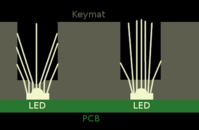Neelix
Insecticidal Maniac
Except that with the keyboard backlight, lighting up the area above the keymat well isn't actually the goal. The goal is specifically to light up the areas under the key markings over as wide an area as possible. For that you need to keep the light bouncing around within the keymat material itself for as long as possible. The longer you can keep it in there, the further it should spread within the material. To demonstrate the idea, hold up a piece of white paper near a lamp that's next to a wall and notice the effect that has on the light coverage on the wall itself.
What that picture and the effects you pointed out tell me is that you'll most likely get the best results if there is a layer of opaque white paint directly over the silicone on the top of the mat itself and the sides of the keys, leaving only the key tops transparent. Colouring the PCB under the keyboard white would also be useful or the same reason.
That done you can colour the top of the painted keymat any colour you like, (including black) and it will have no effect on how far light carries within the material.
- Neelix
What that picture and the effects you pointed out tell me is that you'll most likely get the best results if there is a layer of opaque white paint directly over the silicone on the top of the mat itself and the sides of the keys, leaving only the key tops transparent. Colouring the PCB under the keyboard white would also be useful or the same reason.
That done you can colour the top of the painted keymat any colour you like, (including black) and it will have no effect on how far light carries within the material.
- Neelix


